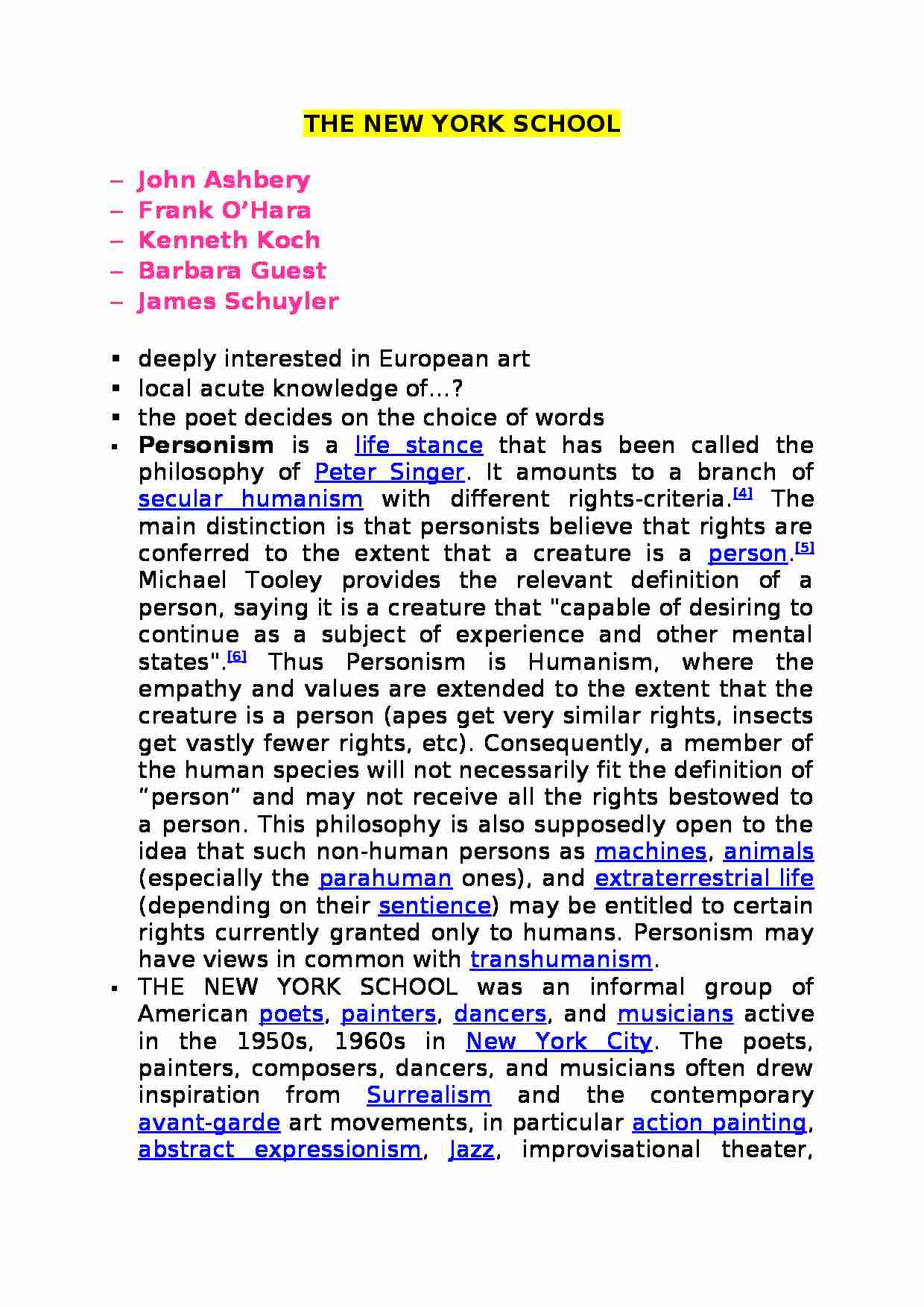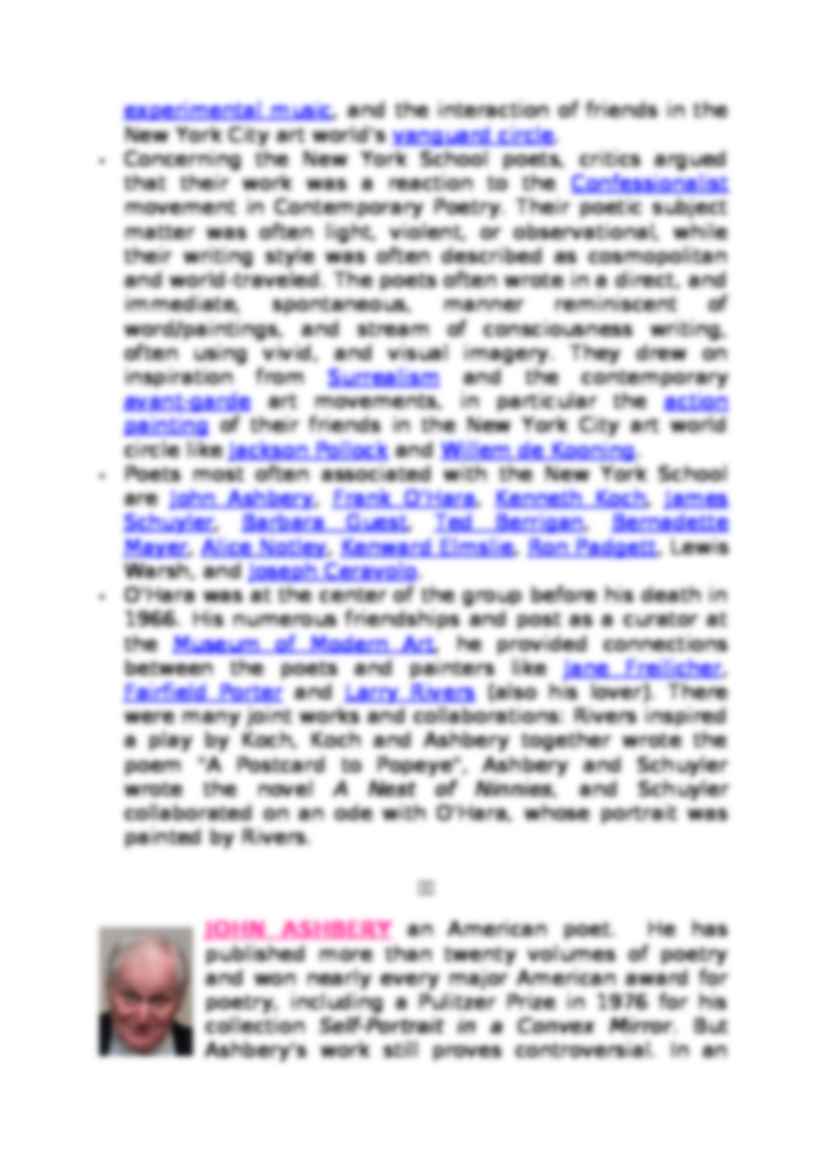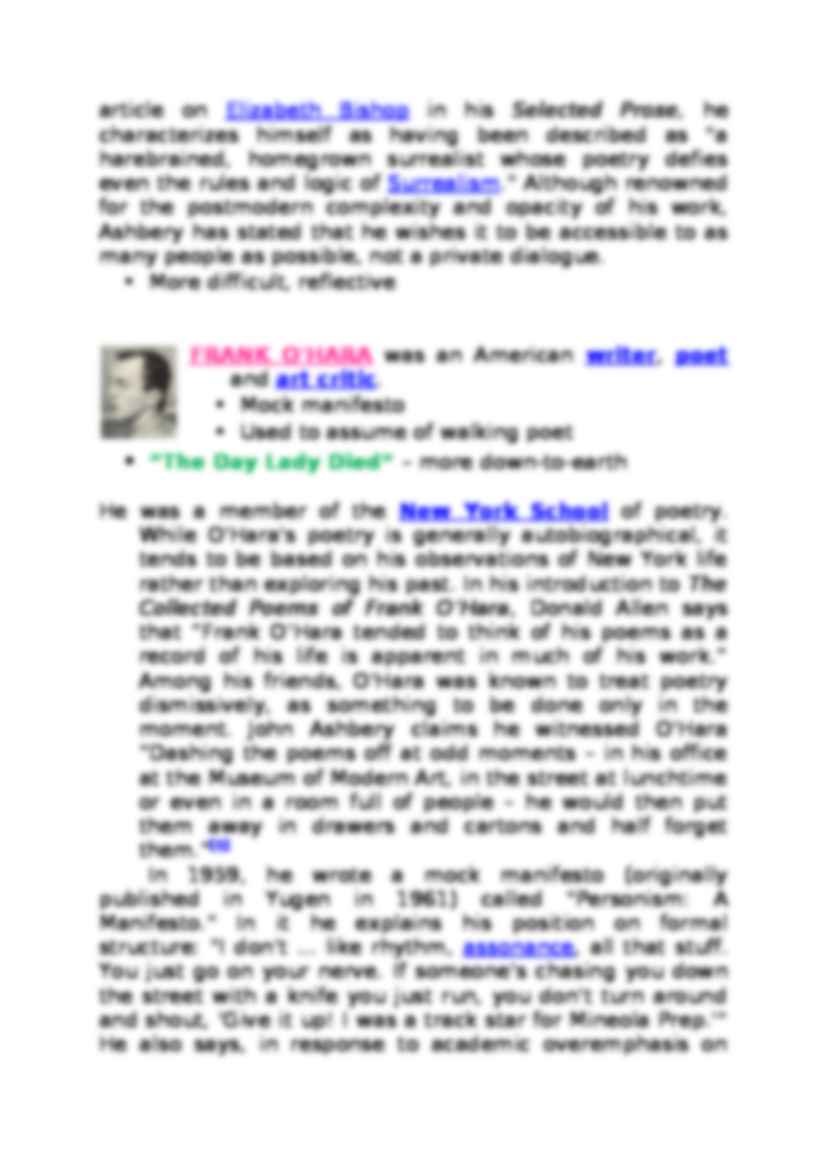The New York School
John Ashbery
Frank O'Hara
Kenneth Koch
Barbara Guest
James Schuyler
deeply interested in European art
local acute knowledge of…? the poet decides on the choice of words
Personism is a life stance that has been called the philosophy of Peter Singer. It amounts to a branch of secular humanism with different rights-criteria.[4] The main distinction is that personists believe that rights are conferred to the extent that a creature is a person.[5] Michael Tooley provides the relevant definition of a person, saying it is a creature that "capable of desiring to continue as a subject of experience and other mental states".[6] Thus Personism is Humanism, where the empathy and values are extended to the extent that the creature is a person (apes get very similar rights, insects get vastly fewer rights, etc). Consequently, a member of the human species will not necessarily fit the definition of “person” and may not receive all the rights bestowed to a person. This philosophy is also supposedly open to the idea that such non-human persons as machines, animals (especially the parahuman ones), and extraterrestrial life (depending on their sentience) may be entitled to certain rights currently granted only to humans. Personism may have views in common with transhumanism.
The New York School was an informal group of American poets, painters, dancers, and musicians active in the 1950s, 1960s in New York City. The poets, painters, composers, dancers, and musicians often drew inspiration from Surrealism and the contemporary avant-garde art movements, in particular action painting, abstract expressionism, Jazz, improvisational theater, experimental music, and the interaction of friends in the New York City art world's vanguard circle.
Concerning the New York School poets, critics argued that their work was a reaction to the Confessionalist movement in Contemporary Poetry. Their poetic subject matter was often light, violent, or observational, while their writing style was often described as cosmopolitan and world-traveled. The poets often wrote in a direct, and immediate, spontaneous, manner reminiscent of word/paintings, and stream of consciousness writing, often using vivid, and visual imagery. They drew on inspiration from Surrealism and the contemporary avant-garde art movements, in particular the action painting of their friends in the New York City art world circle like Jackson Pollock and Willem de Kooning.
Poets most often associated with the New York School are John Ashbery, Frank O'Hara, Kenneth Koch, James Schuyler, Barbara Guest, Ted Berrigan, Bernadette Mayer, Alice Notley, Kenward Elmslie, Ron Padgett, Lewis Warsh, and Joseph Ceravolo.
O'Hara was at the center of the group before his death in 1966. His numerous friendships and post as a curator at the
(…)
… Willem de Kooning.
Poets most often associated with the New York School are John Ashbery, Frank O'Hara, Kenneth Koch, James Schuyler, Barbara Guest, Ted Berrigan, Bernadette Mayer, Alice Notley, Kenward Elmslie, Ron Padgett, Lewis Warsh, and Joseph Ceravolo.
O'Hara was at the center of the group before his death in 1966. His numerous friendships and post as a curator at the Museum of Modern Art, he…
….” Among his friends, O'Hara was known to treat poetry dismissively, as something to be done only in the moment. John Ashbery claims he witnessed O'Hara “Dashing the poems off at odd moments - in his office at the Museum of Modern Art, in the street at lunchtime or even in a room full of people - he would then put them away in drawers and cartons and half forget them.”[6]
In 1959, he wrote a mock…
… the late 40s and early 50s and of the imaginative realism of painters like Jane Freilicher and Larry Rivers.
the Museum of Modern Art (MOMA) the largest museum of modern art and photography in the world. The collection starts with works from 1880. It opened in New York in 1939. Cultural centre moved from Paris to New York
Group of painters
Their activity - Jackson Pollock (a US artist who…
… provided connections between the poets and painters like Jane Freilicher, Fairfield Porter and Larry Rivers (also his lover). There were many joint works and collaborations: Rivers inspired a play by Koch, Koch and Ashbery together wrote the poem "A Postcard to Popeye", Ashbery and Schuyler wrote the novel A Nest of Ninnies, and Schuyler collaborated on an ode with O'Hara, whose portrait was painted by Rivers.
John Ashbery an American poet. He has published more than twenty volumes of poetry and won nearly every major American award for poetry, including a Pulitzer Prize in 1976 for his collection Self-Portrait in a Convex Mirror. But Ashbery's work still proves controversial. In an article on Elizabeth Bishop in his Selected Prose, he characterizes himself as having been described as "a harebrained…
…, homegrown surrealist whose poetry defies even the rules and logic of Surrealism." Although renowned for the postmodern complexity and opacity of his work, Ashbery has stated that he wishes it to be accessible to as many people as possible, not a private dialogue.
More difficult, reflective
Frank O'Hara was an American writer, poet and art critic. Mock manifesto
Used to assume of walking poet
“The Day Lady…
... zobacz całą notatkę






Komentarze użytkowników (0)